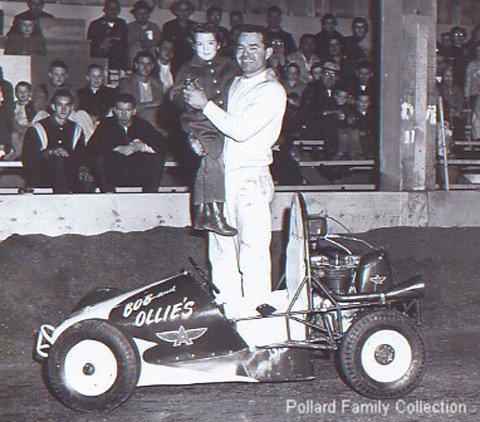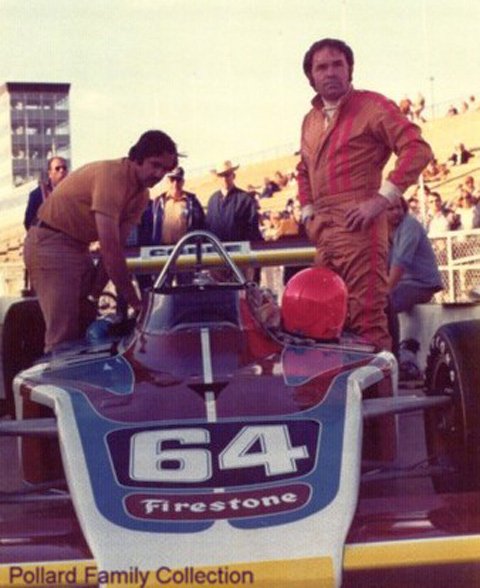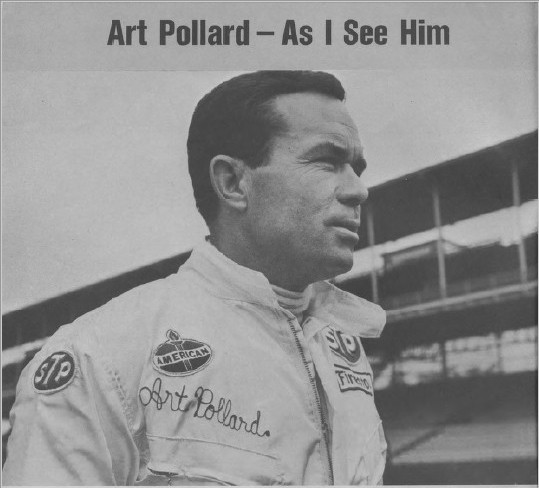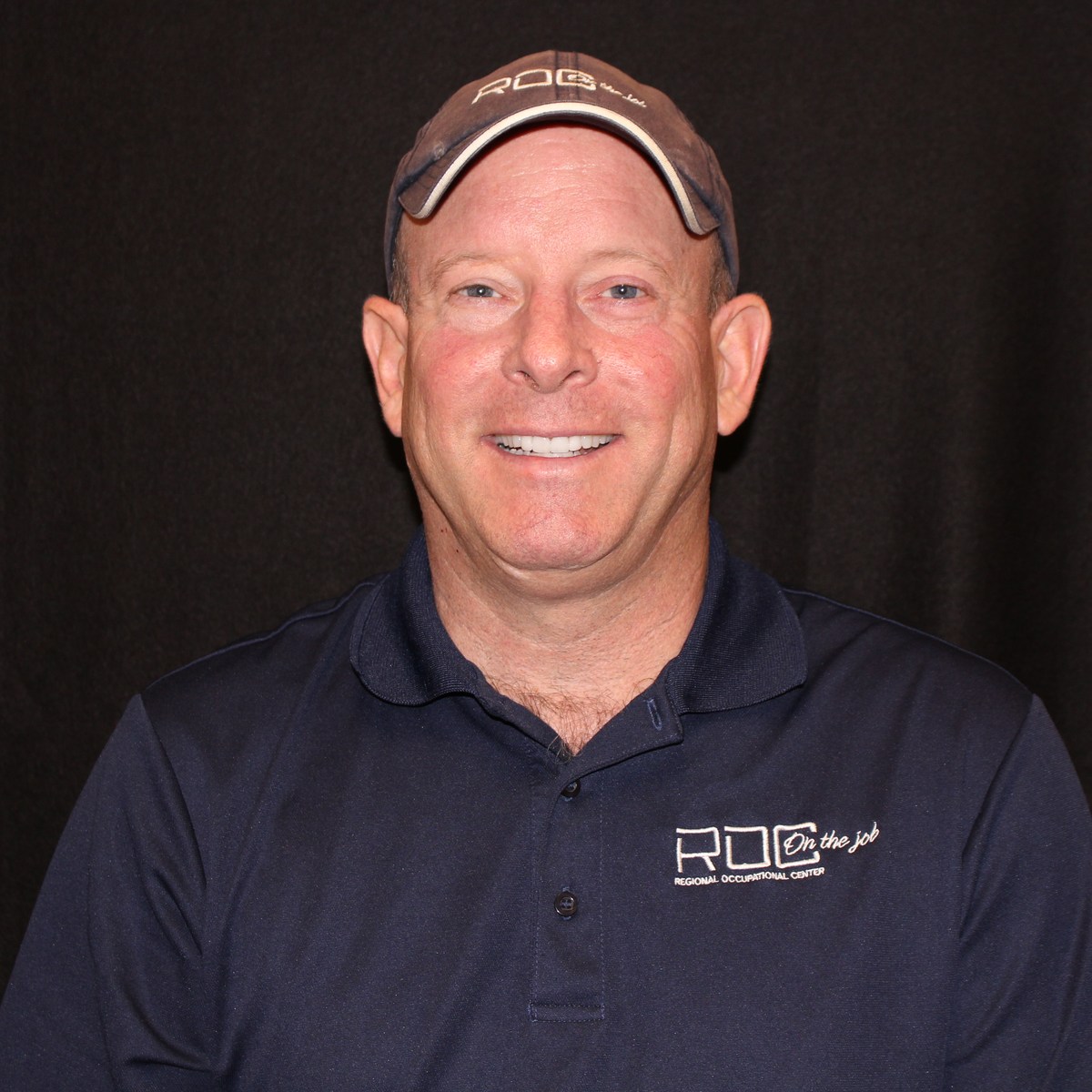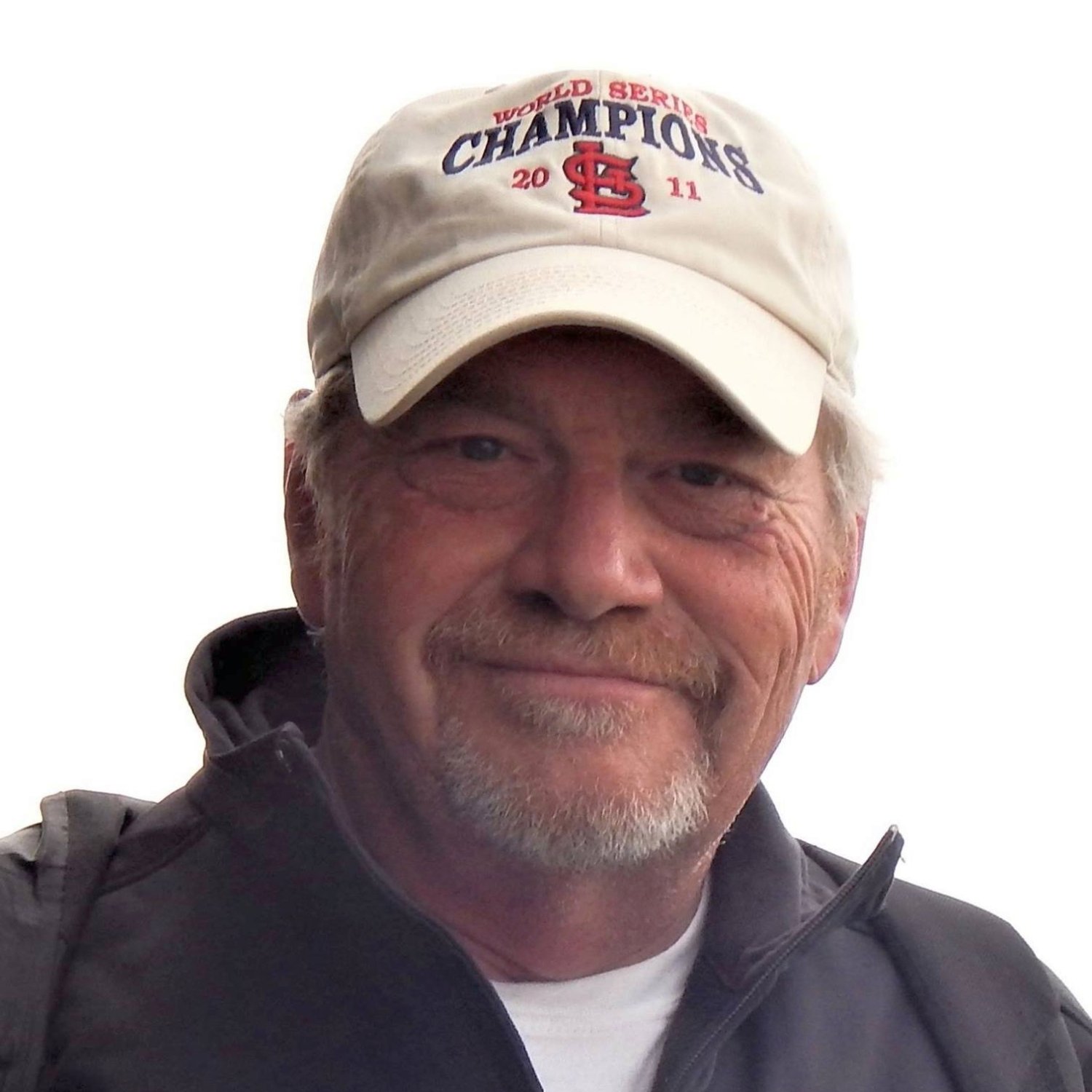Friends and Family Remember May 12 1973
Some Stats are from Motorsport.com
Photo courtesy of Mike Pollard. 1954 – Art competes in Bob and Ollie’s Micro-Midget at the Roseburg Fairgrounds in Oregon. Art is shown holding his three year old daughter Judy.
Remembering May 12, 1973
Art’s friend Johnny Rutherford remembers, “I was the first one by the scene of the accident where he crashed. It was horrendous and I could tell it was not good. I went out in qualifying later and set a new track record. Approximately one hour after the accident, Art Pollard was pronounced dead. He had suffered internal lung lesion due to flame inhalation, a broken leg, a fractured right arm, third-degree burns and a severe spinal injury.
The pride of Roseburg and Medford, Oregon had driven his last lap. A proud family man, a well-respected competitor, a humanitarian, and a friend to all, was gone. He had just turned 46-years-old one week earlier.
Art’s wife, Pat Pollard, was unable to get to a phone before the general media reported Art’s accident and subsequent death. “All I asked was if they’d give me time to call his family in Oregon,” Pat recalls. “Somebody from the hospital released the news, but I was not able to get in touch with anybody before the news became public.”
On the west coast, daughter Judy (then 23-years-old) and son Mike (25-years-old) heard this shocking and unwelcome news on radio and television in the early morning hours.
As Judy relates, “There is no good way to get the horrible news that your dad has had an accident and died. From the time I was a little girl, I never thought it would happen to him. He did everything so well. Racing families never think it will be their loved-one. We just don’t!”
“It was hard, and I still miss having him in my life,” adds Judy. “Even though it was so hard to lose him, I find tremendous solace in my faith and the fact that I had such a loving dad. I was lucky to have him for a dad, even if I had him less time than I wanted. He died living his dream, doing what he loved; and it was a privilege for him to race at that level.”
Mike Pollard, was working as a steel fabricator for Fred Gerhardt in Fresno, California. He turned away from the flatbed truck he was working on when the radio news mentioned his father’s name. Mike couldn’t believe what he was hearing. “Back then, the ‘Wide World of Sports’ televised the qualifier, but they did radio updates every thirty minutes,” Mike said. “Once I got the news I called the hospital, but by then he had passed away. Later Mike would often recall, “You never saw him when he wasn’t smiling.”
Bob Pollard (Art’s brother) and his wife, Diane, were also living in California at the time. “We were listening to the radio broadcast of the activity at Indy when they announced that Art had crashed and later passed away in the hospital. The original comment we heard on the radio was ‘Veteran driver Art Pollard was killed at the Speedway this morning.’ Our mom, Bobbie Pollard, called after the announcement, asking if what she heard was true. It’s a shame she had to hear about Art over the radio, but that’s the way things happen when a sporting event is being broadcast.”
As Harvel Pollard (Art’s cousin) remembers, “One of the fellows I coached with for a number of years wasn’t feeling well that day. I got up early and went to visit him. After a while, I told my friend that I had to get back home to watch the time trials. As I was driving along I had the radio on, and that’s when I heard about Art’s crash. His death hit my family very hard, and to this day we miss him. He was so funny, kind, and always put other people first. Bob Kehoe’s book, Art Pollard: The Life and Legacy of a Gentleman Racer, Chapter 30 “May 12, 1973”
Lifelong friends respond to Art’s fatal accident, May 12, 1973
Don Caskey was on his tractor when his wife Shirley called him inside on May 12, 1973.
Bob Green remembers that windy Saturday morning, too; can’t forget it really. It was one of the most miserable weekends of his life.
Both men stood frozen in their separate locations as news broke on the radio that their friend, Art Pollard, had died in a crash on Pole Day at the Indianapolis Motor Speedway. It was just a week after the local hero’s 46th birthday.
“Just a tragedy,” Green said.
Art’s son, Mike, turned away from the flatbed truck he was working on when the radio newsman uttered his father’s name. Mike, then 25 and a steel fabricator in Fresno, Calif., didn’t want to believe what he was hearing.
“Back then, the Wide World of Sports televised the qualifier, but they did radio updates every 30 minutes,” Mike said. “Once I got the news I called the hospital, and by then he had passed away.”
Fast forward 36 years. Caskey is 81 and Green is 85. Mike lives in Reno, Nev., and works at a jewelry shop. None of the men ever forgot about May 12, nor did they let their glowing recollections of the man they called friendly, loving and “one of a kind” fade.
“You never saw him when he wasn’t smiling,” Mike said.
Pollard was known as a giving man who did things like visit troops in Vietnam and give speeches at churches and high schools all over the nation. He visited children at La Rue Carter Hospital in Indianapolis, where a playground there was named after him. On the track, he won 83 championship events and became one of Southern Oregon’s biggest stars in Indianapolis.
“He was a natural race car driver,” Caskey said. “It came automatic to him.”
Green, who lives in Eugene, was once Pollard’s body and paint man. After four years in the Navy, he went to work at Hansen Chevrolet, where Art was a mechanic.
“We just took to each other,” Green said. “The racing thing interested me also.”
In 1948, Green and Caskey traveled with Pollard to race tracks all over the West Coast and Canada to compete in micro-midget and hard-top events. Ken Glass, a long-time Roseburg resident, sponsored Art’s car until Indianapolis came calling and the rates simply got too expensive.
The men invested countless evenings in the garage, burning the midnight oil to help transform an old 1933 Chevy Coupe into a bonafide competitor.
“Each year it got a little faster and a better car, and then we he started going to out-of-town races,” said Green, who was a body shop mechanic for more than 40 years. “It was a lot of fun.”
Pollard moved in next door to Caskey in 1944. The two went to high school together, played football together and even ended up at the same Navy base in San Diego. After his time in Roseburg, Pollard left for Medford and later became a national figure.
But he never forgot about his old friends.
“He was a real nice guy and we got along very well,” Green said. “Of course, he got along with everyone real well.”
With Pollard’s legacy in mind, the Douglas County Speedway and ASA/Northwest Sprint car Racing Association host’s an annual Art Pollard Memorial race each year in July on a Saturday night.
Photo courtesy of Bob Pollard. June 8, 1969 – The STP team showed up at Milwaukee with Greg Weld in the #57 STP Gerhardt Offy and it was a good thing. A 10 car pile up on the opening lap eliminated Art and the #40 car. After 1 lap, Art replaced Weld in the #57. He sliced and diced his way up through the field and took the lead from STP teammate and Indy 500 winner Mario Andretti. He never looked back. Art went on to win his first Champ Car race after a wild start (shown above). He earned 300 points and $17,362.00. ($117,009.92 in 2017 dollars – Enough to pay cash for a house in some Cities).
KDRV TV, Channel 12, Medford, Oregon
A TV news report, that included interviews with friends and daughter, Judy Dippell
By Ron Brown
May 28, 2010
Sunday marks the 99th year of what many call “the greatest spectacle in racing,” the Indianapolis 500.
MEDFORD, Ore. – Among those starting their engines in the 1950s, 60s and early 70s were two Southern Oregon natives, Bob Christie of Grants Pass and Art Pollard of Medford.
Christie was born in Grants Pass in 1924 and helped his family raise hops. But it was his love of adventure that got him into racing stock cars and midgets in the 40s and 50s. By the mid-50s, he was winning races all over the West Coast and attracted the attention of an Indy car owner in Southern California. Bob Stewart was a member of his first crew at Indianapolis, and a life-long friend.
“We got treated terrible until we qualified. We were kind of a joke. Then all of a sudden we broke through that, and Bruce bought us white pants, we had Levis and t-shirts–and then about that time, we gained the respect of the rest of the people,” Stewart said.
Henry Martin always admired Bob Christie. His father’s Studebaker dealership sponsored his midget race car. Martin says Bob Christie was a class act in the racing community.
“What I really admired about Bob Christie was that he was such a gentleman on the track. At the Brickyard, back in Indianapolis, they always knew him as the kinda’ guy that looked out for the other drivers. He had a high sense of ethics,” Martin said.
Christie started at Indianapolis every year from 1956 to ’63. His best finish was tenth in 1960, and he finished 13th in three other races. He is believed to be the first driver from Southern Oregon to race at Indy. He died of natural causes last year, at the age of 85.
Another Southern Oregon racer began his career at Indianapolis just a few years after Bob Christie retired. Like Christie, Art Pollard of Medford began his racing career in midgets and stock cars. In the fifties he soon built a reputation as a tough competitor. His racing career started in Roseburg racing hydroplanes on the Umpqua River, and micro-midgets at the fairgrounds.
“He was always racing. His racing was not professional in the Northwest and the Western states. It did provide money. He earned money doing it, but like my mom tells it, it pretty much just broke us even, and we could travel and not go into debt, because he won all the time. And so that helped. It wasn’t big money, but enough to do what we needed to,” Judy Dippell said.
By the mid-60s, car owners were trying to talk Pollard into driving their cars at Indianapolis. His first attempt fell short in 1966, but in 1967 he qualified to start 13th and finished 8th. He went on to qualify for six races, but broke his leg in a qualifying accident in 1972 and had to sit out that race. But more often than not, car trouble kept him from winning the big prize at Indy.
Despite his hard luck with cars, Pollard quickly gained a strong fan base, not just from Southern Oregon, but at Indy as well.
“He was just an everyday, common person that shared stories. He liked to have fun. And it was like talking to your next door neighbor. And you don’t always get that from, not just race drivers, but also other stars so-to-speak. And that was the most impressive thing,” Bobby Plump said.
Plump organized charity basketball games that Pollard helped promote with other drivers, in addition to his own charity work at an Indianapolis hospital.
“The Art Pollard Day in May continued for decades after dad’s death. And I think it was a tribute to him and the fact that he cared. Not just for publicity, but sincerely cared for people,” Dippell said.
Legendary Track Announcer Tom Carnegie says Pollard carried a high level of sportsmanship and driving that attracted fans.
“I think he was probably the first driver that we had who helped local people. He went to a hospital locally and started visiting that hospital and bringing drivers with him. And that soon became a tradition, and he was the first one to do that. He was very popular, very quiet, but on the race track, very successful,” Carnegie said.
But the luck and success ran out preparing for the 1973 Indy 500, a race remembered for deadly accidents. In time trials, with a car with the new air wing design, and running in high winds, the car went out of control and flipped several times at speeds over 190 miles an hour. He was rushed to Methodist Hospital, but died shortly afterward.
“Tom Carnegie, you know, the voice of Indy, when he says, after being there 60 years, that dad was the most loved driver among the other drivers, that means more than if he ever won Indianapolis to me. Maybe not to dad, because I think he took the relationships he had for granted, because he was that way though his whole life. He was a people magnet, and I feel privileged that he was my dad, for that reason. He was a good dad. So it was being a good father, a good man, and a person of integrity that I admire,” Dippell said.
Art Pollard — As I See Him by Andy Granatelli, Auto Racing Magazine Of The World’s Greatest Sport, August 1969
Art’s Indy car racing career summary: 1965 through 1972
Note: Prior to 1965 Art won 83 championship events in the Western States and Canada and became one of Southern Oregon’s biggest stars.
Races entered: 82 (1965–1972)
Wins: 2
Podiums: 5
Pole positions: 2
1965: 3 races; 0 wins; 0 Podiums; 0 Pole Positions
1966: 7 races; 0 wins; 0 Podiums; 0 Pole Positions
1967: 10 races; 0 wins; 0 Podiums; 1 Pole Position
1968: 20 races; 0 wins; 0 Podiums; 1 Pole Position
1969: 18 races; 2 wins; 3 Podiums; 0 Pole Positions
1970: 10 races; 0 wins; 1 Podium; 0 Pole Positions
1971: 10 races; 0 wins; 1 Podium; 0 Pole Positions
1972: 4 races; 0 wins; 0 Podiums; 0 Pole Positions
Indy 500 Record:
1967: Car #16; Thermo-King; Laps completed: 195; Start 13; Finished 8
1968: Car #20; STP; Laps completed: 188; fuel shaft failure; Start 11; Finished 13
1969: Car #40; STP; Laps completed: 7; driveline failure; Start 12; Finished 31
1970: Car #10; Car Wash Systems; Laps completed: 28; Piston failure; Start 6; Finished 30
1971: Car #64; Gilmore; Laps completed: 45; Valve failure; Start 31; Finished 26
Art qualified in the field for the 1972 race, but broke his leg in a post-qualifying accident and was unable to race.
Art died in Indianapolis, Indiana as a result of injuries sustained in practice for the 1973 Indianapolis 500.
He drove in the USAC Championship Car series, racing in the 1965-1973 seasons, with 82 career starts, including the 1967-1971 Indianapolis 500 races. He finished in the top ten 30 times, with 2 victories, both in 1969, at Milwaukee and Dover. He had just turned 46 one week before he died.
Photo courtesy of Mike Pollard. 1961 – Art Pollard won the 1961 Western States Race of Champions with the ’34 Willys racer with a longer chassis and some added body work and a new fuel tank which increased the weight to 2050 pounds. The two day event was held at the Kearney Bowl in Fresno California. On Friday Art qualified fastest with a new track record. He also won the “A” Dash, the “Fast Heat” Race, and all three of his 25 lap main events. On Saturday Art broke his own track record from the day before, again he won the “A” Dash, the “Fast Heat” Race, and two out of three of his 25 lap main events and finished 2nd in the other. Art Pollard was crowned Champion (shown above) and awarded a 9′ 2″ trophy after compiling 1,150 out of a possible 1,200 points over the two days.
Email to Art’s brother, Robert “Bob” Pollard
Nov 19, 2010
Bob,
I discovered an interesting fact the other day while following some of your links. I was surprised to find the site honoring your brother, his career, and untimely death.
I actually had an opportunity to meet him once in Lexington. I do not immediately recall the year, but one of our local motorcycle shops hosted him and his Indy car for a promotion. Being a big race fan, I was fortunately allowed to go.
Somewhere in my possessions I have an autographed photo of Art and the Indy car. If I can find it, I will attach a shot of it in another e-mail.
I suppose there is truth in the 7 – degrees of separation theory.
I am sorry that you lost him at such an early age, but I thought you might appreciate knowing that a while ago, he made a young boys day.
Bill White
Variety Video Gallery
PLAYLIST
1. 2016 Indy 500 Opening Tease ABC
2. Pre Race Events – 100th Running of the Indianapolis 500 – 2016, Marc Evans
3. 1970 Indianapolis 500 [ESPN Classic Telecast Version] (Full Race)
Art Pollard interview at about 26:45
4. 1971 Indianapolis 500
Art Pollard interview at about 45:12
5. Robin Miller’s 2016 Christmas Gifts Suggestions including Art Pollard: The Life and Legacy of a Gentleman Racer by Bob Kehoe

